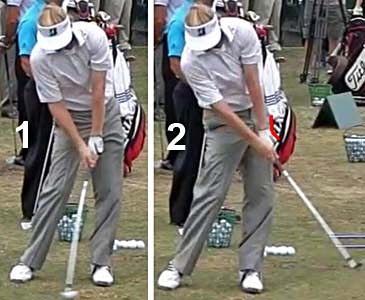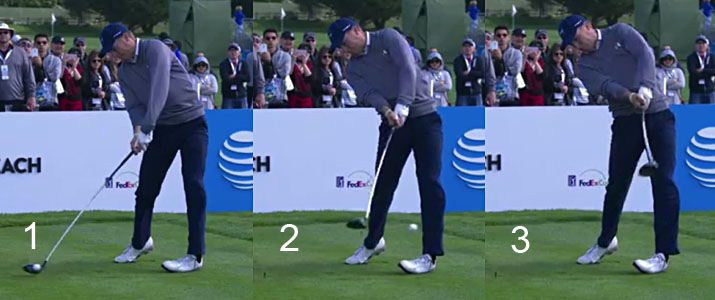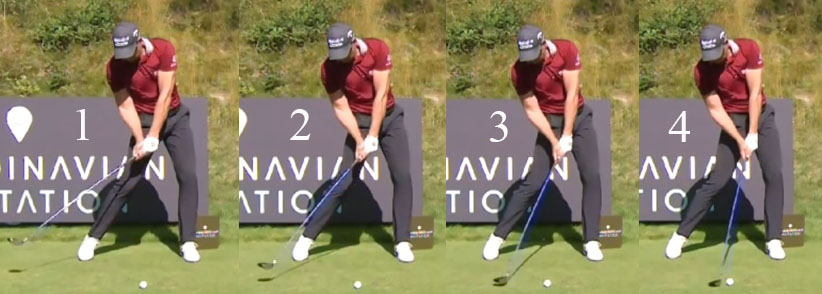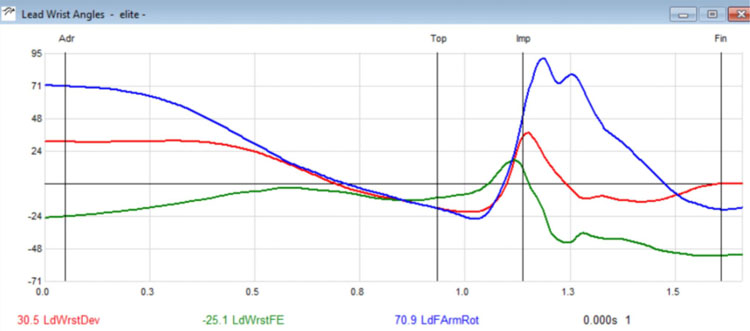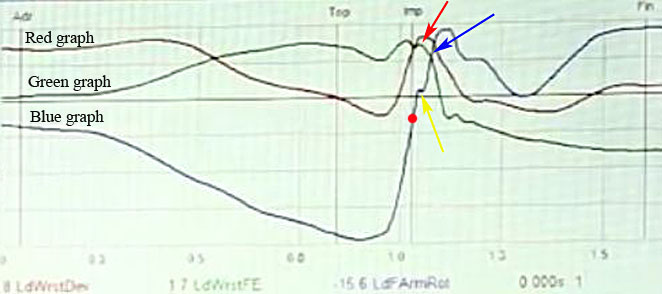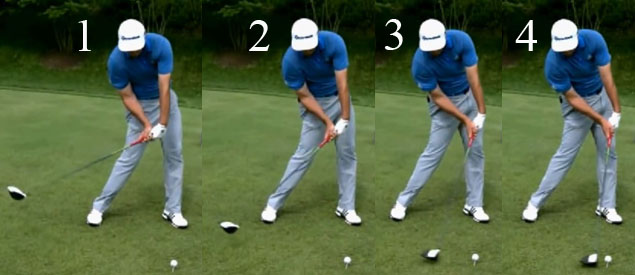Post by imperfectgolfer on Sept 26, 2020 13:07:49 GMT -5
In this post, I am going to analyse the "real life" effects of left wrist bowing on the golf swing of a pro golfer, and I will use Collin Morikawa as my first example.
CM uses a weak left hand grip and he starts to bow his lead wrist during the backswing so that he has an overtly bowed lead wrist by P4.
So, consider CM at his P4 position.
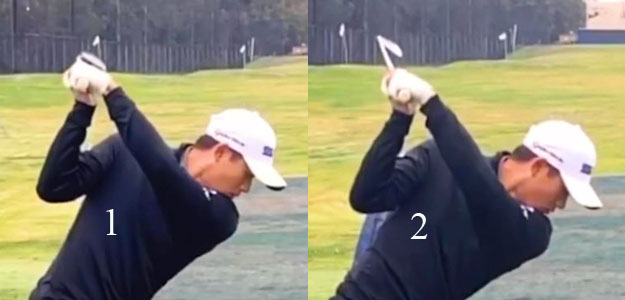
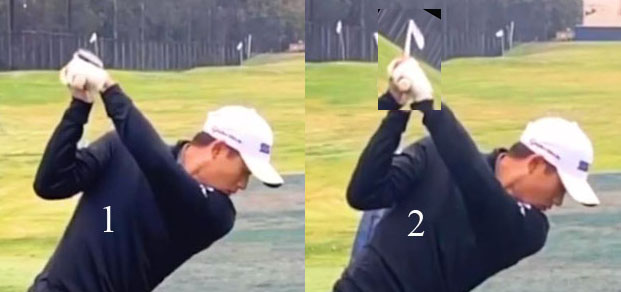
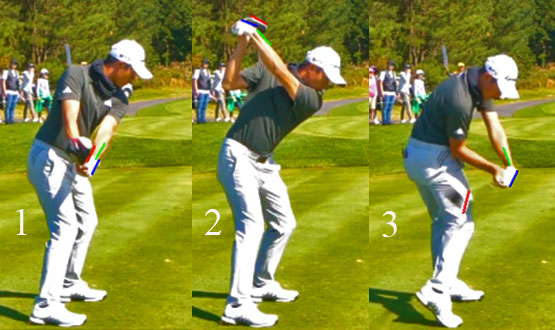

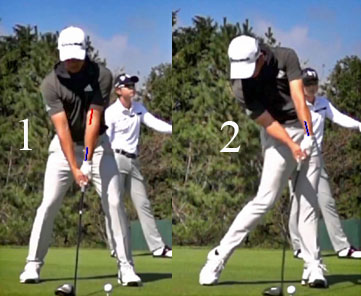
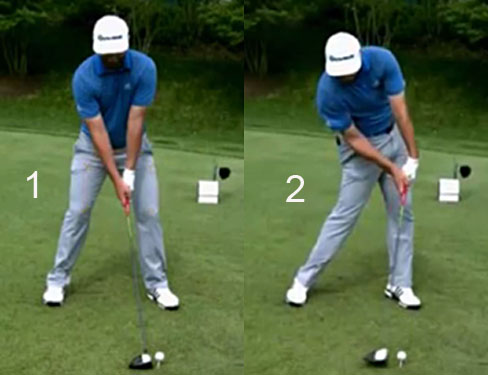

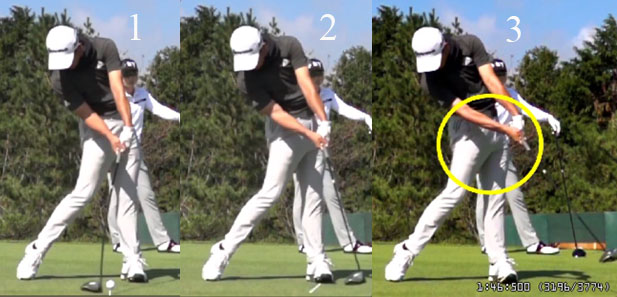
CM uses a weak left hand grip and he starts to bow his lead wrist during the backswing so that he has an overtly bowed lead wrist by P4.
So, consider CM at his P4 position.

Image 1 shows his driver swing and image 2 shows his short iron swing.
Note that the degree of lead wrist bowing is similar in both images.
I measured the angle difference between the back of his lead forearm and his clubface to determine his degree of clubface closure at the P4 position and it measured 25 degrees. Note that I am using the back of his lead forearm as my reference point while JS in his demo-image measured a 40 degree angle change because he used a cupped lead wrist as his starting reference point. A slightly cupped lead wrist (10-15 degrees cupped) would be a good reference point for a golfer who uses a neutral lead hand grip, but a pro golfer who uses a weak lead hand grip will more likely have a flat lead wrist at the P4 position if he uses an intact LAFW technique where the clubshaft is straight-in-line with the lead forearm at P4.
Here is my altered image of the above CM image where I used a Photoshop technique to change image 2 to an intact LAFW alignment where bowing is absent and where the clubface is straight-in-line with his lead forearm.

I measured the difference in clubface angle between image 1 and image 2 and I got a measurement of 25 degrees.
Why is his clubface closed by 25 degrees at the P4 position? The correct answer is that his lead wrist is bowing when his lead wrist is radially deviated, and that causes clubshaft rotation with very little clubshaft angulation (note the small difference in clubshaft angulation between image 1 and image 2 and note that it is slightly more angulated to a "laid-off" position in image 1).
Now, let's consider what happens to his degree of lead wrist bowing and his degree of clubface closure between P4 and P6.

Image 1 is at P2, image 2 is at P4 and image 3 is at P6.
I have drawn a green line along the back of his lead forearm, a blue line along the back of his lead hand and a red line along his clubface and you can see that those 3 lines are parallel to each other at the P2 position - because he has an intact LAFW alignment and he has not yet started to bow his lead wrist.
Note that his lead wrist bowing phenomenon at the P4 position (image 2) causes the clubface (red line) to be more closed relative to the lead forearm (green line) by ~25 degrees.
At the P6 position (image 3), his lead wrist appears to be even more bowed (relative to his lead forearm) and I used Photoshop to measure the angle difference between the blue line and the green line and it came to ~40 degrees. This Photoshop measurement cannot be truly accurate because the lead hand and lead forearm are in two different planes and my Photoshop measurement is contaminated by a parallax error of unknown degree. The red line does not appear to be parallel to the blue line and that is likely due to parallax error due to the fact that his clubshaft is now angled back. I cannot accurately measure the degree of his clubface closure (relative to the clubhead arc) at the P6 position, but let's presume that it is about 30 degrees closed.
Now, let's consider what happens in the later downswing.

Image 1 is at the P6.2 position, image 2 is at the P6.5 position, image 3 is at the P6.8 position and image 4 is at impact.
Let's presume that his clubface is still closed to his clubhead arc by about 30 degrees (compared to an intact LAFW scenario) at his P6.2 position as a result of his lead wrist bowing phenomenon that happened between P4 => P6 (when his lead wrist was radially deviated to a significant degree). Theoretically, that could be an advantage because it could potentially decrease the amount of lead forearm supination required during his PA#3 release action in order to get a square clubface by impact.
However, that theoretical advantage would only really apply if he converted from having a bowed lead wrist to having a non-bowed lead wrist at ~P6 and if he came into impact with a non-bowed lead wrist and no forward shaft lean. The "true life" reality is that CM still maintains a markedly bowed lead wrist between P6 => P7 (when his lead wrist is becoming increasingly ulnar deviated) and that lead wrist bowing phenomenon (when the lead wrist is ulnar deviated) causes a large degree of clubshaft angulation away from the target. Note that his lead forearm (green line) has already reached the ball position by P6.5 (image 3) while his clubshaft is angled far back (away from the target) due to his continuing lead wrist bowing action happening in his late downswing when his lead wrist is becoming increasingly ulnar deviated.
What would happen to the clubface if a golfer has a lot of forward shaft lean in the later downswing (due to a lead wrist bowing phenomenon that angles the clubshaft back away from the target)? It would naturally open the clubface relative to the ball-target line. That means that the golfer still needs to enact a lot of lead forearm supination in the later downswing in order to get a square clubface by impact. Note how much CM's lead forearm has to supinate between P6.5 (image 3) and impact (image 5) - you can look at the degree of rotation of his left lower radial bone, or the watchface area of his lead lower forearm, or the back of his lead hand to get a visual impression of the approximate degree of lead forearm supination happening between P6.5 => P7. In fact, I strongly suspect that this clubshaft angulation phenomenon happening in the later downswing (due to lead wrist bowing when the lead wrist is ulnar deviated) has a greater effect on opening the clubface that is greater in amount than the clubface closing benefit due to lead wrist bowing happening in the early-mid downswing when the lead wrist is radially deviated!
Does CM have to use more lead forearm supination in his later downswing in order to get a square clubface by impact as a result of his lead wrist bowing technique that generates a lot of forward shaft lean by impact - compared to another pro golfer who uses a weak lead hand grip and who uses a non-bowed lead wrist technique and who has no forward shaft lean at impact? I suspect that the answer is affirmative!
Consider these capture image of CM at address (image 1) and at impact (image 2).

I have drawn a blue line over his lead lower radial bone at the level of his lower lead forearm and a red line down the middle of his lead antecubital fossa.
Note that his clubshaft is straight-in-line with his lead forearm at address and he has no forward shaft lean. Note that his lead antecubital fossa partially faces the camera at address because his lead humerus is not internally rotated very much at address (which is a frequent phenomenon in golfers who adopt a weak neutral lead hand grip).
Note how much his hands are ahead of the clubhead at impact (image 2) due to his marked degree of lead wrist bowing. Also, note that his lead humerus is more internally rotated at impact, which causes his lead antecubital fossa to be angled more away from the target (compared to image 1). Look at how much his left lower radial bone is rotated counterclockwise relative to his lead antecubital fossa at impact, and it suggests that his lead forearm is more supinated at impact compared to its degree at address.
Here are capture images of Jon Rahm (who also uses a weak lead hand grip) at address (image 1) and at impact (image 2).

Close-up views of the above image.

Note that Jon Rahm looks nearly identical to CM at impact - i) his lead humerus is internally rotated more at impact compared to address, ii) his hands are ahead of the clubhead and he has a similar amount of forward shaft lean and iii) his lead lower radial bone is rotated more counterclockwise relative to his lead antecubital fossa by a similar amount. For Jon Rahm to acquire those biomechanical features at impact, he has to use more lead forearm supination than usual during his PA#3 release action and his lead forearm is more supinated at impact than it was at address (according to a 3D graph that I will present when I analyse Jon Rahm's swing action in a future post).
Although I do not have a 3D graph of CM's golf swing action to prove that he uses more lead forearm supination during his PA#3 release action than usual - compared to a golfer who adopts a weak lead hand grip and a non-bowing lead wrist technique - due to his lead wrist bowing action happening in the later downswing when his lead wrist is significantly ulnar deviated, I strongly suspect that he does (based on the remarkable similarity of his impact alignments compared to Jon Rahm).
I am notorious for routinely advocating the intact LAFW/GFLW golf swing technique, but I actually think that the bowed lead wrist technique (as executed by CM) has three advantages over the intact LAFW/GFLW technique.
1) It closes the clubface by ~30 degrees during the earlier downswing and that makes the clubface transition to the clubface closing phenomenon that happens in the later downswing (during the PA#3 release action) more gradual (and not suddenly abrupt as seen in Phil Mickelson's driver swing action).
2) It makes it easier for a golfer to acquire forward shaft lean at impact, which is very desirable when it comes to solid ball-striking.
3) It is very conducive to performing a drive-hold hand release action through impact.
Here are capture images of CM's DH-hand release action.

Note how CM keeps the clubface square to his clubhead arc between impact (image 1) and P7.4 (image 3) and this is more easily possible because he comes into impact with a bowed lead wrist and he maintains his bowed lead wrist, and avoids lead wrist flipping, between P7 and P7.4.
Jeff.

